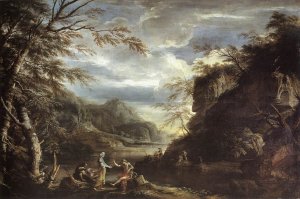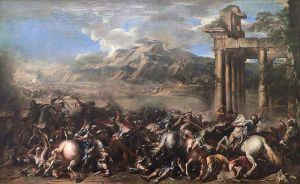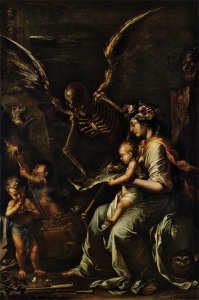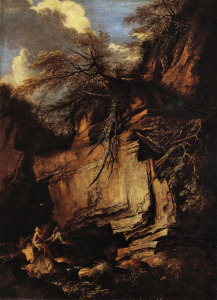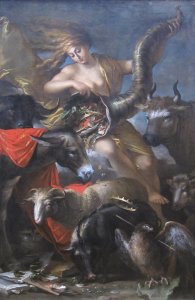CLASS: BONE DEEP GOTHIC
Curious what this is all about? Find out here!
If Rosa’s years in Florance were to be some of the happiest and most productive in his life, his ambition was not content to make a permanent home there. In 1649, he relocated Lucretia and the rest of his family to Rome, and while he would periodically make trips to Naples, Venice, and other parts of the Italian peninsula, this city would be Rosa’s base-of-operations for the rest of his life.
While both Florence and Rome were powerful cities enjoying a certain amount of prestige, the culture between the two was vastly different. Florence, situated in the pastoral Tuscan countryside and abiding the centuries-long dynasty of the Medici was more isolated, provincial, and supportive of the eccentric genius. Rome, by contrast, was both mindful of its ancient history and majesty and of its present clout as the seat of the papacy. Papal patronage was the ultimate triumph of a striving Italian artist, and Rosa had already come far from his humble roots on the outer edges of Naples.
Some of Rosa’s attitudes about art had also changed over the years; in his prior residency in the Eternal City, Rosa had studied the earthy, novelty bamboccianti school of painting. Now he adopted the longstanding and critically mainstream position that the best art — indeed, the only worthy art — was grand in both subject and scale, and small, common subjects were an insult to the genre.
For a time, Rosa’s ambitions appeared to bear fruit. Although he had several children with Lucrezia, he did not much concern himself with them, sending them instead to live in orphanages. Rosa’s friends in Rome (Cardinal Brancaccio) and Florence (Ricciardi) continued to support his work financially and critically. At last, Rosa’s serious work, the works he attended with the most passion, and often painted on immense canvases, attracted public adulation and the praise of cardinals and popes. In particular, after painting a massive Heroic Battle for the French nunciate Cardinal Neri Corsini, Rosa received invitations to join the royal courts of both Austria and Sweden. Queen Christina of Sweden might be said to be one of the greatest patrons of the arts in the 17th century.
Rosa’s moment of triumph was cut short, however, by the same intemperance that has caused him to abandon Rome in 1640. He joined three academies and wrote vicious satires, attacking some of the most prominent and well-connected artists in Rome at the time. This practice, in addition to Rosa’s relentless self-promotion at exhibitions, was met by sharp retaliation. While in 1640 it had been simple enough for Rosa to decamp to another city, ten years later he did not want to relinquish his newly prestigious commissions. The risk was also greater; rather than being a lone genius trying to build his reputation, Rosa had relocated to the home of the Inquisition, and had brought his married lover and some of their children with him. While Rosa’s patrons and promoters within the Vatican prevented him from coming to direct harm as a result of these indiscretions, he nonetheless thought it prudent to send Lucrezia and their son to stay with family in Naples.
Then, in the most tragic moment of Rosa’s life — a moment that seemed ripped from the Greek mythology so often the subject of his paintings — the plague struck Naples, killing Rosa’s son and most of Lucrezia’s family. When she returned to him in Rome, she returned on her own.
Eventually, however, fortune turned in Rosa’s favor once more. Cardinal Fabio Chigi ascended to the papacy as Alexander VII, a much more enthusiastic patron of the arts than his predecessor. In Rome, papal energy had a profound effect on money and commissions available to artists. Alexander’s pontificate was no exception, and the famously death-obsessed pope acquired Rosa’s bitter painting, Frailty of Human Life.
Interestingly, although the affinities of Frailty and the Witchcraft paintings to contemporary gothic are obvious today, the first English gothicists owe their greatest debts to Rosa’s landscapes of his later Roman period. As we shall soon see, this was because the gothicists recognized links between Rosa’s fierce landscapes and the aesthetic of the sublime, by which pleasure and insight can be drawn from the contemplation of awful things.
As noted before, Rosa’s understanding and experience of his own work is much different from that of the gothicisits. For Rosa, his private passions were for his ruminatory philosophical paintings, while his public triumph were in grand historic treatments, like the Heroic Battle pictured above. At the time, landscapes had only recently emerged as a “fitting” subject according to Rosa’s Roman critical judgments. They had historically been considered an inferior genre, but had recently gained prestige after receiving grand and serious treatments by Nicolas Poussin and other painters from Northern Europe. Rosa did appreciate the scale possible in landscape paintings, and their potential for classical and Biblical treatments such as in his Apollo and the Cumaean Sibyl and Saint Anthony Abbot and Saint Paul the Hermit. These paintings, characterized by stormy skies, craggy rocks, sinister woods, and wild-looking hermits informs — far more than Frailty or Scene of Witchcraft — the gothic imagination of the following century. Rosa’s Landscape with Hermits, pictured below, contains all of these elements:
At any rate, Rosa’s landscapes continued to sell well, while his favorite projects languished at the exhibitions, unable to attract the high prices for which he hoped. As with earlier frustrations, Rosa wrote angry and public satires — this time attacking, indirectly, the pope and his family — and as had happened in the past, his life and career were threatened with reprisal. This, in conjunction with his biting painting of Fortuna, in which fickle fortune favors the dumb and the ignorant, led to a furor. Looking at Fortuna below, keep in mind that the dirty and indifferent animals staring listlessly at a shower of riches are not only to represent a callous and clueless public, but also famous artists, cardinals, and the patrons who had supported Rosa after his move to Rome.
At 45, Rosa was not a young man anymore, and both a growing depression and anxiety, and his bitterness at what he felt was a lack of appreciation for his talents and depth of insight would characterize his work from this point onward.

